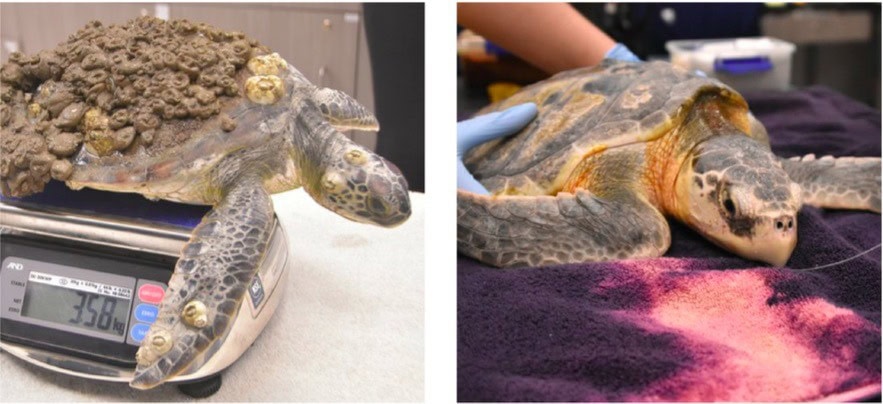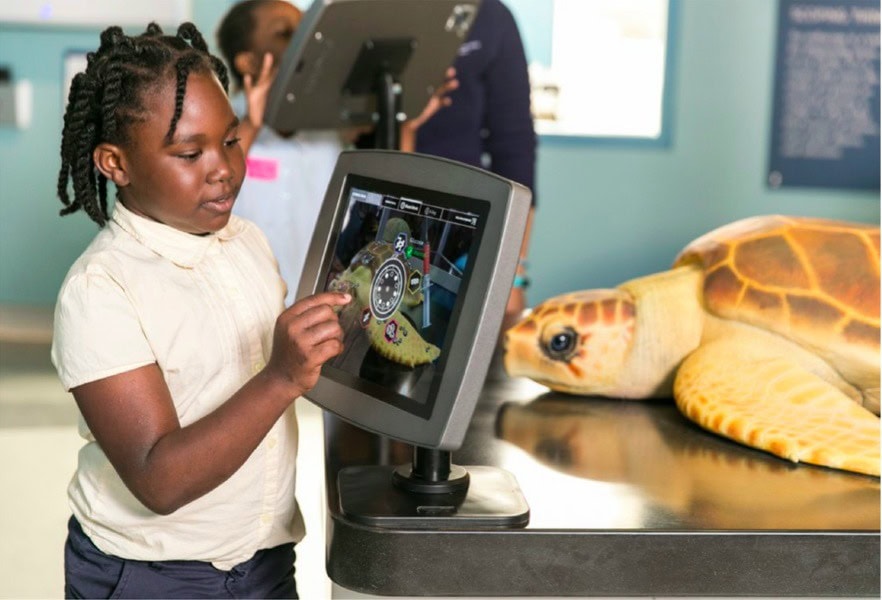WRITTEN BY Bek Mitchell-Kidd
Florida is home to five species of sea turtles, including hawksbill, Kemp’s ridley, loggerhead, leatherback and green. All five species are listed as either threatened or endangered.
Along the Florida coast, sea turtles annually make between 40,000 and 80,000 nests. Females nest every two to three years, laying eggs in several nests on sandy beaches. After digging a hole and depositing approximately 80 to 120 eggs, the females fill in the hole with sand and camouflage the nest before returning to the sea.
Sea turtle eggs incubate for a period of about two months. It is a myth that hatchlings need a full moon to find the ocean—they successfully emerge from their nests during all phases of the moon. Turtle hatchlings dig out of their nest at the same time, a process that can take several days. They leave the nest as a group at night and head directly for the sea.
Sea turtles are born with the instinct to move toward the brightest direction. On a natural beach, this direction is the light of the open horizon. Their first trek “imprints” their home beach into the hatchlings. Once grown, turtles return to create their nests on the same beach.
A sea turtle’s average lifespan is from 40 to 60 years, with adults ranging in weight from the smaller Kemp’s at approximately 100 pounds to the leatherback which can reach up to 1,300 pounds.
Only about one in 1,000 turtles survives to adulthood. Hatchlings die of dehydration if they don’t make it to the ocean fast enough. Birds, crabs and other animals also prey on young turtles.
Given the stable year-round temperatures in the Sunshine State, the Florida Fish and Wildlife Conservation Commission and other local organizations often partner with groups looking to release rehabilitated turtles into warmer waters, including the South Carolina Aquarium in Charleston, SC.
In partnership with the South Carolina Department of Natural Resources (SCDNR), the South Carolina Aquarium Sea Turtle Care Center works to rescue, rehabilitate and release sea turtles that become stranded along the South Carolina coast. Located in the Aquarium, the Care Center admits 20 to 30 sea turtles each year. Many of these animals are in critical condition.
According to SCDNR, during the past 10 years, the average number of sea turtles stranded on South Carolina beaches each year is 128. Of these, roughly 10 percent are alive and successfully transported to the Sea Turtle Care Center. To date, the South Carolina Aquarium has successfully rehabilitated and released 249 sea turtles.


Two recent success stories include Crush and Fluke. Crush was stranded in Jarvis Creek near Hilton Head Island, SC. A green sea turtle, Crush was found floating at the surface of the water and was unable to dive. Crush had a heavy epibiota load of sea squirts and barnacles on his top shell and was affected by the cold weather and water temperatures off the South Carolina coast.
Fluke, a Kemp’s ridley, was “caught” by a fisherman at Price Inlet, near Caper’s Island, SC. Unfortunately, Fluke had swallowed the line and required surgery to remove the hook.
After months of treatment and rehabilitation, both turtles were released into the warm waters of Big Talbot State Park, Jacksonville, FL, with PIT tags (PIT tags are similar to microchips and can be scanned).
To find out more about sea turtle rescue efforts, check out:
The Whitney Lab-Sea Turtle Hospital, St. Augustine
The Marine Science Center, Ponce Inlet
South Carolina Aquarium’s Sea Turtle Care Center, Charleston
Ways You Can Help Sea Turtles
- Organize a beach clean-up day.
- Never leave fishing line behind.
- Do not feed sea turtles or other wildlife.
- Reduce the amount of plastic garbage you produce.
- Turn off the lights. Keep beachfront lights off throughout the night from May to October as they can confuse sea turtles during the mating season.
- Reduce the amount of fertilizers you use. Lawn and garden fertilizers wash into coastal waters, killing plants and animals.
- Don’t release helium balloons. They end up drifting into the oceans where sea turtles mistake them for one of their main food sources, jellyfish.

Leave a Reply